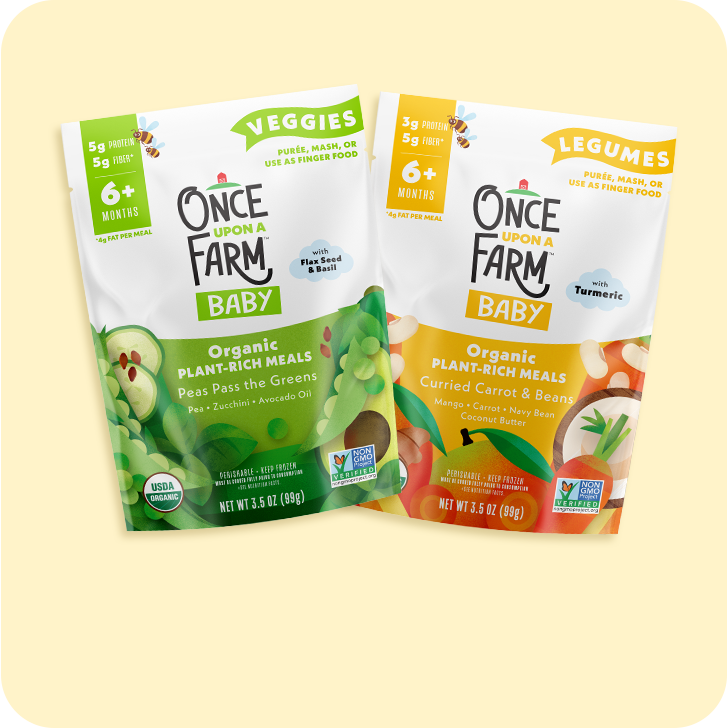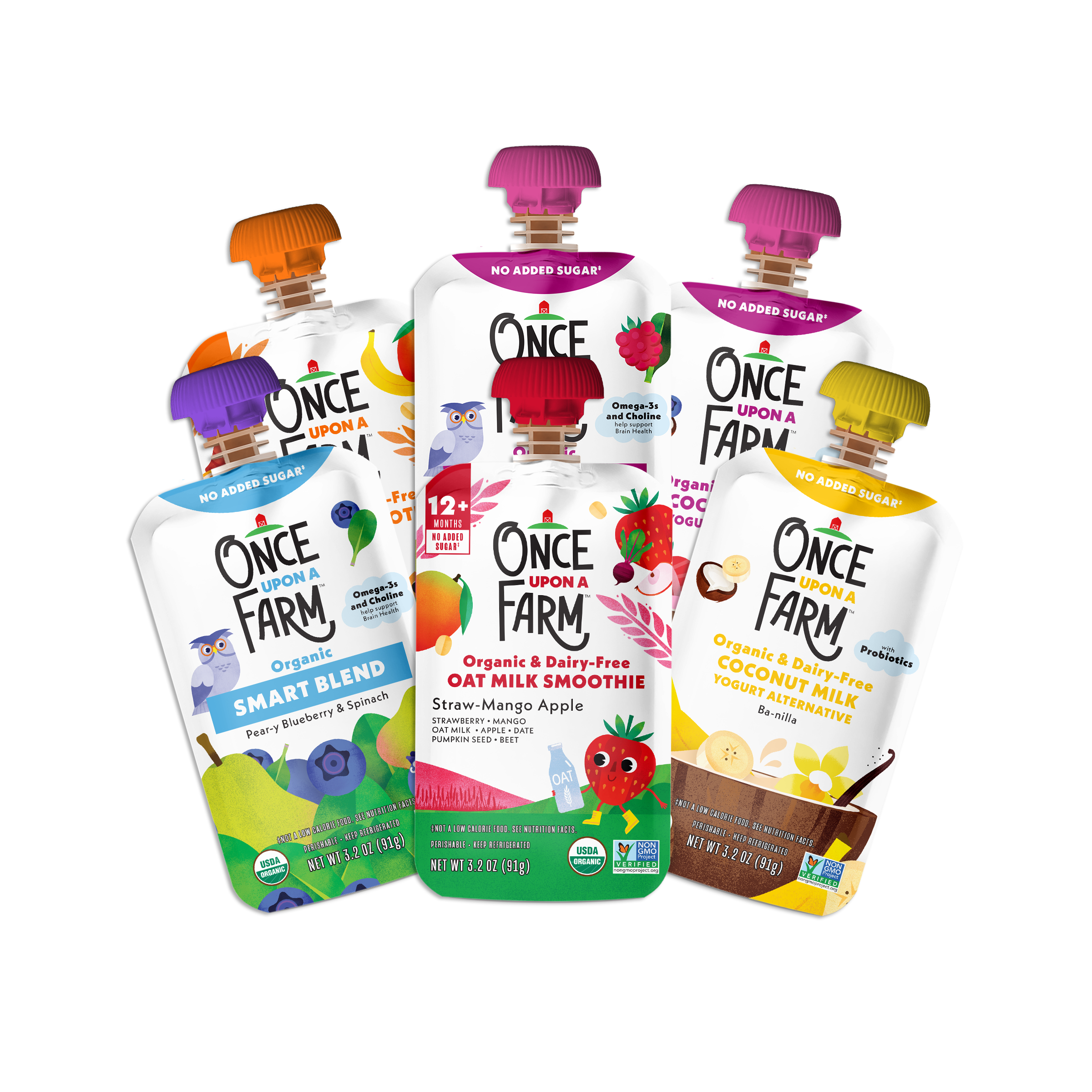Note: This blog is not medical advice and is for informational purposes only. For any specific recommendations or questions, please refer to your child’s healthcare provider. If you believe your child is experiencing an allergic reaction, please call 911.
While it’s an exciting time, starting solids can also bring stress as you’re embracing a lot of unknowns and firsts. Introducing allergens can be especially anxiety-provoking for parents and, because of that, it’s a topic we hear about a lot from our community.
To find out what questions parents were asking, we hosted a Q&A in our private Facebook group with O’Farm Expert, pediatrician Joana Fraser, MD on the topic of allergens. We’re sharing those questions anonymously below, to help you make informed decisions about your family’s food journey.
Don’t miss the chance to ask your questions during our next expert Q&A!
Do different allergens cause different responses, or are reactions all the same?
Joana Fraser, MD: Different allergens do not cause different reactions. There are two main ways an allergy to food will present. One way an allergy can show up is fairly quickly after eating the food with symptoms such as rash, face/lip swelling, and if very serious (anaphylaxis), there will be difficulty breathing and/or abdominal pain and vomiting. Or, an allergy to a food might have symptoms such as abdominal pain, mucus and/or blood in the stool (poop), and general fussiness. These symptoms might not show up until several days after eating the food and are generally less serious as they are not signs of anaphylaxis.
When we start to introduce foods, do we need to do one at a time?
JF: The only foods I would be more cautious with introducing are the major allergens (dairy, egg, peanut, tree nut, soy, shellfish, fish, wheat). Try these individually for a few days before introducing another allergen so that you can identify any possible reactions. For foods that are not allergens, I do not think it is necessary to introduce them separately!
When should you introduce nuts to babies?
JF: As soon as you begin to introduce other solid foods! A landmark study published in 2015 (the LEAP study) showed that introducing peanuts as early as 4 months of age, and continuing to give them regularly, significantly reduced the risk of peanut allergy. I recommend peanut butter as a great way to do this, mixing a small amount with baby oatmeal or even just putting a little on a teething toy for them to gnaw on.
How do we introduce some of the harder things like cashews, pistachios, and walnuts?
JF: These can be tricky! I love nut butters for introducing all types of nuts, mixed into oatmeal or spread onto toast and cut into small pieces. These types of nut butters are harder to find but they are out there! You can also try chopping them into tiny pieces and incorporating them into baked goods like banana bread.
What’s the best time to introduce shellfish?
JF: As soon as you can! And, just as importantly, continue to give it regularly (once every 1–2 weeks). For younger babies who need softer foods, I love crab or lobster cakes as these can be broken up easily and are quite mushy. For older babies (1 year+), cutting shrimp into tiny bites appropriate for their pincer grasp is a good option, too.
Does the fact that one parent has a shellfish allergy increase the likelihood of the child being allergic? How do we handle introducing this?
JF: You are at an increased risk of developing an allergy if any types of allergies are present in the family. So, I would just go for it! We know that waiting longer to introduce allergens can increase the likelihood of developing an allergy. Maybe try it on a weekend day when both parents are around and you can monitor for a reaction afterwards. You can also have some Benadryl on hand in case you see any rash or other symptoms developing.
Is it possible to fix or grow out of a dairy allergy?
JF: I feel your pain! Two of my kids struggled with this. If their symptoms are GI based (tummy pain, blood in their poops), the best thing is to occasionally give them small amounts of dairy for a few days and watch for symptoms. I’d start with baked goods containing dairy, then if this goes well, try cheese or yogurt before moving to cow’s milk. The good news is the vast majority of kids outgrow this.
If the allergy is one which results in rash and/or anaphylaxis, I would consult your child’s allergist about the best way to introduce dairy.
My daughter has stool reactions to both dairy and eggs. No skin reaction. Would this still be considered an allergy?
JF: This may be an allergy or an intolerance. The only way to know for sure if/when it has resolved is to occasionally ‘challenge’ her with these foods (i.e., give her small amounts every few days and watch for symptoms). You should start with one food and, only once that is tolerated, move to the next. I would also recommend initially giving it baked into something (i.e., a baked good with eggs as an ingredient, but not dairy) and then, if that is tolerated, you can try the ‘whole food’ (i.e. scrambled eggs).
I have a nut allergy. We’ve introduced peanut butter once to my daughter. I’m nervous to give it a second time as I’ve heard the second exposure can show signs of an allergy. Advice?
JF: You’re right that it takes more than one exposure to develop an allergy, but the only way out of this is through! It’s best to give allergenic foods regularly, the idea being that then the body is less likely to see them as ‘foreign’. So, pick a day soon when you ideally have a partner or family member around too—and life isn’t too crazy—and just go for it! You can also have some Benadryl on hand for extra peace of mind.
My first child has an egg allergy. Does that make it more likely for my second child to also have it? How closely linked are egg and peanut allergy?
JF: Having an immediate family member with an allergy increases your risk for developing an allergy, and if you already have an allergy, you are at higher risk of developing other allergies. If you are allergic to a tree nut you are also more likely to be allergic to other tree nuts. Similarly, if you find you are allergic to crab, you are more likely to be allergic to crab because the proteins in these groups of foods are similar. That being said, even if your child has an egg allergy, I would still follow the guidance to introduce peanut early and often unless there is another medical reason for not doing this.
Suppose our immune system is responsible for the response to our various allergens, and some have a lifelong allergen issue. Are there ways to “reprogram” the response or eliminate known substances the body deems toxic to reduce allergic responses?
JF: That is such a great question and one I know that allergists/immunologists are definitely working on! Certain types of allergies are potentially treatable with allergy immunotherapy, otherwise known as desensitization therapy. This is where small amounts of the allergen are introduced via shots or orally (by mouth) and the amount is increased each time to hopefully allow the body to get used to the allergen without recognizing it as foreign and causing an allergic reaction. This type of treatment should always be done under the close care of a Board-Certified Allergist.
Don’t miss our next expert Q&A!





















